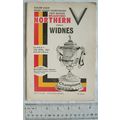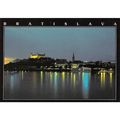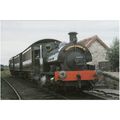Aircraft - Gloster Javelin FAW9, Duxford - Museum postcard c.1970s
- Condition : Used
- Dispatch : 2 Days
- Brand : None
- ID# : 140774429
- Quantity : 1 item
- Views : 414
- Location : United Kingdom

- Seller : justthebook (+1704)
- Barcode : None
- Start : Mon 06 Jul 2015 11:10:44 (BST)
- Close : Run Until Sold
- Remain : Run Until Sold
More Listings from This Seller view all
Seller's Description
- Postcard
- Picture / Image: Gloster Javelin FAW9, Aircraft Collection at Duxford Airfiled No. 12
- Publisher: Imperial War Museum, London
- Postally used: no
- Stamp: n/a
- Postmark(s): n/a
- Sent to: n/a
- Notes / condition:
Please ask if you need any other information and I will do the best I can to answer.
Image may be low res for illustrative purposes - if you need a higher definition image then please contact me and I may be able to send one. No cards have been trimmed (unless stated).
------------------------------------------------
Postage & Packing:
Postage and packing charge should be showing for your location (contact if not sure).
No additional charges for more than one postcard. You can buy as many postcards from me as you like and you will just pay the fee above once. Please wait for combined invoice. (If buying postcards with other things such as books, please contact or wait for invoice before paying).
Payment Methods:
UK - PayPal, Cheque (from UK bank) or postal order
Outside UK: PayPal ONLY (unless otherwise stated) please. NO non-UK currency checks or money orders (sorry).
NOTE: All postcards are sent in brand new stiffened envelopes which I have bought for the task. These are specially made to protect postcards and you may be able to re-use them. In addition there are other costs to sending so the above charge is not just for the stamp!
I will give a full refund if you are not fully satisfied with the postcard.
----------------------------------------------
Text from the free encyclopedia WIKIPEDIA may appear below to give a little background information (internal links may not work) :
*************
The Gloster Javelin was a twin-engined all-weather interceptor aircraft that served with Britain's Royal Air Force in the late 1950s and most of the 1960s. It was a T-tailed delta-wing aircraft designed for night and all-weather operations and was the last aircraft design to bear the Gloster name. Introduced in 1956 after a lengthy development period, the aircraft received several upgrades during production to its engines, radar and weapons, including support for the De Havilland Firestreak air-to-air missile. The Javelin was succeeded in the interceptor role by the supersonic English Electric Lightning, introduced only a few years later. The Javelin and Lightning served together for many years, with the last Javelins being removed from service in 1968.
In the aftermath of the Second World War, Britain identified a threat posed by the jet-powered strategic bomber and atomic weaponry and thus placed a great emphasis on developing aerial supremacy through continuing to advance its fighter technology, even following the end of conflict. Gloster Aircraft, having developed and produced the only Allied jet aircraft to be operational during the war, the Gloster Meteor, sought to take advantage of its expertise and responded to a 1947 Air Ministry requirement for a high-performance night fighter under Air Ministry specification F.44/46. The specification called for a two-seat night fighter, that would intercept enemy aircraft at heights of up to at least 40,000 feet. It would also have to reach a maximum speed of no less than 525 kts at this height, be able to perform rapid ascents and attain an altitude of 45,000 feet within ten minutes of engine ignition.[1]
Additional criteria given in the requirement included a minimum flight endurance of two hours, a takeoff distance of 1,500 yards, structural strength to support up to 4g manoeuvres at high speed and for the aircraft to incorporate airborne interception radar, multi-channel VHF radio and various navigational aids. The aircraft would also be required to be economical to produce, at a rate of ten per month for an estimated total of 150 aircraft.[2]
Gloster would produce several design proposals in the hope of satisfying the requirement. P.228, drawn up in 1946, was essentially a two-seat Meteor with slightly swept wings. A similar design was also offer to the Royal Navy as the P.231.[3] The later-issued P.234 and P.238 of early 1947 had adopted many of the features that would be distinctive of the Javelin, including the large delta wing and tailplane.[4] The two differed primarily in role; P.234 was a single-seat day fighter with a V-tail, while P.238 was a two-seat night fighter with a mid-mounted delta tailplane.[3]
The RAF requirements were subject to some changes, mainly in regards to radar equipment and armaments; Gloster also initiated some changes as further research was conducted into the aerodynamic properties of the new swept and delta wings, as well as use of the new Armstrong Siddeley Sapphire turbojet engine.[5]
On 13 April 1949, the Ministry of Supply issued instructions to two aircraft manufacturers, Gloster and de Havilland, to each construct four airworthy prototypes of their competing designs to meet the requirement, as well as one airframe each for structural testing. These prototype aircraft were the Gloster GA.5 and the de Havilland DH.110, the latter of which held the advantage of also being under consideration for the Royal Navy.[6] Development was considerably delayed through political cost-cutting measures, the number of prototypes being trimmed down to an unworkable level of two each before the decision was entirely reversed; this led to the unusual situation where the first production Javelin was actually completed prior to the prototype order being fulfilled.[7]
The first prototype was structurally completed in 1951; one unusual feature of the prototypes was the non-transparent canopies over the two-man cockpits, it had been believed that visibility was unnecessary and a hindrance to the observer's role, the only external view available was via small 'portholes'. Following a month of ground testing, on 26 November 1951, the first prototype conducted its first flight at Moreton Valence airfield.[8][9] Bill Waterton, Gloster's Chief Test Pilot, would later describe the Javelin as being ""as easy to fly as an Anson"".[10] Disaster had nearly struck during one test flight when the elevator surfaces detached in mid-flight; despite the lack of control surfaces, Bill Waterton was able to land the aircraft. He would be awarded the George Medal for his actions to retrieve flight data from the burning aircraft.[11]
The second prototype (WD808) received a modified wing in 1953. After initial testing by Waterton, it was passed to another Gloster test pilot, Peter Lawrence[N 1] for his opinion. On 11 June 1953, the aircraft crashed. Lawrence had ejected, but too late (at about 400 ft (120 m)), and was killed. The Javelin had experienced a ""deep stall"", the wing acting like an airbrake had killed forward motion and at the same time stopped airflow over the elevators, leaving them useless. Without elevator control, Lawrence would not have been able to regain control and the aircraft dropped from the sky.[12][13] A stall warning device was consequently specifically developed and implemented for the Javelin.[14]
The third prototype (WT827), and the first to be fitted with operational equipment, including radar, first flew on 7 March 1953.[13] The fourth WT827 was passed to the Aeroplane and Armament Experimental Establishment (A&AEE) for trials and the fifth prototype, WT836, made its first flight in July 1954.[15] On 4 July 1954, a prototype Javelin accidentally achieved supersonic speed during a test flight, the pilot having been distracted by an oxygen supply failure.[16]
The official production order for the Javelin was issued in mid-1953; as the Gloster Meteor was still being actively produced by Gloster, considerable elements of the Javelin were subcontracted out to other aviation companies owned by the Hawker Siddeley Group, such as Armstrong Whitworth.[17] While some delays were incurred, the Javelin's status as a ""super priority"" for production helped to minimise the time involved in producing each aircraft. On 22 July 1954, XA544, the first production aircraft, took flight at Hucclecote. Production would be assisted by a large order placed by the United States Air Force, purchasing a number of aircraft for the RAF as part of the Mutual Defense Aid Program at a price of £36.8 million.[17]
On 21 October 1954, a pilot attached to Gloster from RAE Farnborough was killed while flying Javelin XA546 after having entered what appeared to be an intentional spin.[17] On 8 December 1955, a service test pilot S/L Dick[18] was testing XA561 for the A&AEE when the aircraft entered a flat spin during maneuvers, which the anti-spin parachute could not stop, and he ejected. Following this, a stall-warning device was developed for the Javelin.
By the end of 1956, the Javelin was up to a FAW 7 variant, which was the first to actually meet the specifications of the original Air Ministry requirement, and which was to become the definitive version of the aircraft (most of which were later altered to the FAW 9 standard). Indeed, the Javelin was evolving so quickly that deliveries of the FAW 8 began before FAW 7 production had ended. As a result, the final 80 FAW 7 aircraft went straight from the factory into storage, eventually flying after being re-manufactured as FAW 9s. A total of 427 Javelins were produced in all variants, plus seven prototypes. While there had been considerable interest from several NATO air forces, there would ultimately be no export orders for the Javelin.[19]
The Javelin was the RAF's first purpose-built interceptor aircraft.[20] Aerodynamic features of the type included its adoption of the new delta wing and a large tailplane. Fuel and armaments were housed in the delta wing, while the engines and crew were contained within the fuselage.[21] The delta wing and tailplane combination had been deemed necessary by Gloster for effective manoeuvrability at high speed and for the aircraft to be controllable at low landing speeds.[22] In one instance during testing, when both elevators had been torn off by elevator flutter, the Javelin remained controllable in part due to the aerodynamic qualities of the large tailplane.[23] Changes from the prototypes included alterations to the rear fuselage and lengthened engine jet exhausts, to eliminate buffeting of the rudder by the jet exhaust and increased sweepback of the wing's leading edge to improve high-speed handling.[24]
The Javelin was reportedly easy to fly even on one engine.[25] The flight controls were fully power-assisted and production aircraft adopted a hydraulic 'feel' system for the pilot.[26] The Javelin featured an infinitely-variable airbrake; the airbrake proved to be extremely responsive and effective, allowing pilots to conduct rapid descents and heavy braking manoeuvres, enabling equally-rapid landings to be performed.[27] The turnaround time between sorties was significantly shorter than with the preceding Gloster Meteor, due to improved ground accessibility and engine ignition sequence.[28] Unlike the Meteor, the Javelin was fitted with ejector seats, at the introduction to service of the type.[29]
In spite of the aircraft's unorthodox aerodynamic features, the Javelin had a fairly conventional structure and materials, being mainly composed of an aluminium alloy some use of steel edging.[30][31] The fuselage was composed of four sections, the nose (containing the radar radome), the front fuselage, centre fuselage and rear fuselage; the nose and rear fuselage were removable for servicing and easy replacement. The engines were located on either side of the centre fuselage section, the internal space in the centre containing the service bay that housed much of the aircraft's electrical, hydraulic, and avionics subsystems.[30] The engine air intakes were placed on the forward fuselage, running directly from beneath the cockpit rearwards into the delta wing.[30] Electricity was provided by a pair of 6,000 watt, 24-volt generators driven by the auxiliary gearbox; inverters provided AC power for equipment such as some flight instruments and the radar.[32]
type=printed
period=post-war (1945 - present)
postage condition=unposted
number of items=single
size=continental/ modern (150x100mm)
Listing Information
| Listing Type | Gallery Listing |
| Listing ID# | 140774429 |
| Start Time | Mon 06 Jul 2015 11:10:44 (BST) |
| Close Time | Run Until Sold |
| Starting Bid | Fixed Price (no bidding) |
| Item Condition | Used |
| Bids | 0 |
| Views | 414 |
| Dispatch Time | 2 Days |
| Quantity | 1 |
| Location | United Kingdom |
| Auto Extend | No |



 for 1 item(s)
for 1 item(s)
















